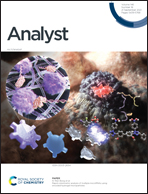A benzaldehyde–indole fused chromophore-based fluorescent probe for double-response to cyanide and hypochlorite in living cells†
Abstract
With the rapid development of various industries, cyanide (CN−) and hypochlorite (ClO−) have a tremendously adverse effect on the health of humans and animals. In this study, a fluorescent probe HHTB based on a benzaldehyde–indole fused chromophore was designed to detect cyanide and hypochlorite simultaneously. The synthesized probe was found to have strong anti-interference ability. In addition, the designed probe could respond rapidly to ClO− in just 80 s, while the color changed visibly from red to colorless. Moreover, the response time to CN− was longer (about 160 s), with the apparent color change from red to light red. The ratiometric and colorimetric absorbance variation of HHTB was due to the nucleophilic attack of CN− on the indole C![[double bond, length as m-dash]](https://www.rsc.org/images/entities/char_e001.gif) N functional group and the strong oxidization of ClO− which destroyed the C
N functional group and the strong oxidization of ClO− which destroyed the C![[double bond, length as m-dash]](https://www.rsc.org/images/entities/char_e001.gif) C bonds and the conjugation systems. Furthermore, the probe HHTB responding to ClO− and CN− presented high sensitivity, as the calculated detection limits were 1.18 nM and 1.40 nM, respectively. The probe was also found to have low biological toxicity and was used in living cells successfully. Therefore, it has good application prospect in the field of cell imaging and biomedicine. The binding mechanism of HHTB–CN and the reaction mechanism of HHTB and ClO− were further elucidated by a series of experiments.
C bonds and the conjugation systems. Furthermore, the probe HHTB responding to ClO− and CN− presented high sensitivity, as the calculated detection limits were 1.18 nM and 1.40 nM, respectively. The probe was also found to have low biological toxicity and was used in living cells successfully. Therefore, it has good application prospect in the field of cell imaging and biomedicine. The binding mechanism of HHTB–CN and the reaction mechanism of HHTB and ClO− were further elucidated by a series of experiments.



 Please wait while we load your content...
Please wait while we load your content...